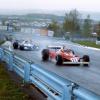Posted 31 July 2002 - 17:41
Some of my favorite Yunick stories have already been told, and that one by 'Mistah Nah' I had never heard of until this moment.
I'm sure that rule bending and breaking has been going on as long as they started writting rules down... it's the nature of the game, especially it seems, in NASCAR.
Darrell Waltrip said after having his qualifying time for the 1976 Daytona 500 disallowed: "If you don't cheat, you look like an idiot. If you do it and you don't get caught, you look like a hero. If you do it and get caught, you look like a dope. Put me in the category where I belong.
In NASCAR's Good Old Days, cheating was rampant. The car builders and mechanics knew more about a car than any NASCAR inspector.
But it was pretty hard to hide things in the days when the cars had to be "showroom" or "strictly" stock. It was a simple matter of going over the car with factory specs. And what didn't comply, was judged illegal, and had to be fixed before you could go on the track. Still, a few found ways to avoid detection. But it wasn't because of expert engineering. One time, Lee Petty drove a car that had a heavy-duty rear end, and an illegal carburetor. When he was called for inspection after the race, he parked the car outside the NASCAR garage and raised the hood. Richard was already turning the bolts to take the old carb off when a couple of inspectors came out and curtly inquired as to why he had the hood up, and that he'd better close it in a hurry. The elder Petty told the inspectors that the radiator was being drained, and that "this boy was new, and has never done this before."
Somehow, the inspectors bought the excuse, went back inside, and left Petty to not only change the carb, but the rear end as well. The car passed inspection with the illegal rear-end and the carburetor sitting right in the trunk.
The Petty family, despite their beloved image, could bend the rules as much as anyone. And when it came time to cheat, their handiwork remained hidden from inspectors because the Petty's were always one step ahead of NASCAR.
An exception to this was Charlotte, 1983.
There are two stories to this saga. Which one to believe is up to you. But legend has it that Richard Petty was caught with an "oversized" engine after the race. Petty was fined, and points were taken away. Something about wax in the cylinders that meletd away, allowing for larger displacement.
But another story that floated around at the time bespoke of the brilliance of Richard's engine builder, his brother, Maurice. The rumor had it that Petty was not found to have an illegal engine, and that the infraction was, in fact, something infinitely more diabolical. During post-race inspection, a hidden compartment was supposedly found in the radiator. In that compartment was a bottle of Nitrous Oxide. The story goes on to tell us that Maurice had rigged this bottle to inject Nitrous into the combustion chamber of the motor via a small hose disguised as the fuel line. The driver could activate the Nitrous from the cockpit, thus giving him 25-30 more horsepower down the straights.
Could it have happened? Of course. Did it? Nobody will tell. Petty won't, and NASCAR sure isn't interested. Both parties are perfectly content to stay with the ‘oversized engine' theory. And why not? After all, had it been publicly revealed that Petty had driven a car so blatantly illegal, NASCAR would have had no choice but to disqualify the car's run altogether to appease the outrage from the drivers, sponsors, and other fans. And that would have meant that Richard Petty would have never attained the record of 200 wins.
The win he was allowed to keep was # 199.
One of the most brilliant bender of the rules was today's current NASCAR technical director, Gary Nelson. Nelson took the word cheating and turned it into an art form. Cars that he wrenched were the ones' to beat.
One involved the cars driven by Darrell Waltrip during one of his championship seasons. Nelson found a way to fill the entire roll-cage of the car with several hundred pounds of buckshot. The car was weighed before the race, and found legal. But when Waltrip went onto the track during pace laps, and reached the banking, he'd pull a hidden lever which allowed the lead to pour from under the car and roll harmlessly down the banking. On the radio, Waltrip would indicate a successful drop by yelling "Bombs Away!" Then, with the car weighing considerably less than the mandated weight, Waltrip would proceed to blow away the field.
NASCAR never discovered this trick. Nelson ingeniously located the exit spout where the jack was positioned. When NASCAR inspectors raised the car with a jack, they concealed the evidence, and cleared the car to qualify and run.
There was a rumor that circulated a few years back that Nelson also engineered a hidden system that injected Nitrous Oxide in the Engines that Darrell Waltrip used at Daytona one year.
When Nelson was working for DiGard, he built a "prototype" car to be entered in the upcoming Firecracker 400 at Daytona. An little-known driver named Greg Sacks took the car and blew away the field. The car was torn apart following the race, but nothing was found, nothing reported, anyway. Nelson's contemporaries still insist today that something was "not right" about that car, and that NASCAR wasn't smart enough to find out why.
It's little wonder that NASCAR tabbed Nelson to replace Dick Beatty. In fact, when the announcement was made, Richard Childress was forced to remark "About 99 percent of the cheating in this sport has just stopped."

























